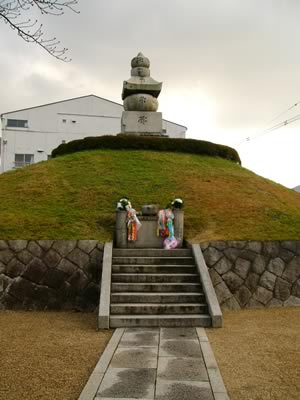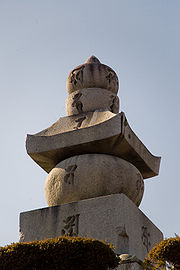
Mimizuka
Encyclopedia

Kyoto
is a city in the central part of the island of Honshū, Japan. It has a population close to 1.5 million. Formerly the imperial capital of Japan, it is now the capital of Kyoto Prefecture, as well as a major part of the Osaka-Kobe-Kyoto metropolitan area.-History:...
, Japan
Japan
Japan is an island nation in East Asia. Located in the Pacific Ocean, it lies to the east of the Sea of Japan, China, North Korea, South Korea and Russia, stretching from the Sea of Okhotsk in the north to the East China Sea and Taiwan in the south...
, dedicated to the sliced ears and noses of killed Korean soldiers and civilians taken as a war trophy
War trophy
In ancient Greece and Rome, military victories were commemorated with a display of captured arms and standards. A trophy was originally a war memorial assembled from such items on a battlefield. The Roman triumph also displayed these items as well as cultural objects, which later came to be...
during the Japanese invasions of Korea from 1592 to 1598. The monument enshrines the mutilated body parts of at least 38,000 Koreans killed during Toyotomi Hideyoshi
Toyotomi Hideyoshi
was a daimyo warrior, general and politician of the Sengoku period. He unified the political factions of Japan. He succeeded his former liege lord, Oda Nobunaga, and brought an end to the Sengoku period. The period of his rule is often called the Momoyama period, named after Hideyoshi's castle...
's invasions.
The shrine is located just to the west of Toyokuni Shrine, the Shinto shrine honoring Hideyoshi in Kyoto.
History

Samurai
is the term for the military nobility of pre-industrial Japan. According to translator William Scott Wilson: "In Chinese, the character 侍 was originally a verb meaning to wait upon or accompany a person in the upper ranks of society, and this is also true of the original term in Japanese, saburau...
would bring back the heads of enemies slain on the battlefield as proof of their deeds. Remuneration was paid to soldiers by their feudal lords based on the severed heads. However, because of the number of civilians killed along with soldiers, and crowded conditions on the ships that transported troops, it was far easier to just bring back ears and noses instead of whole heads. The dismembered facial features were brought to Japan in barrels of brine. Some might have been discarded, so it is impossible to be sure how many were killed during the war.
The Mimizuka was dedicated September 28, 1597. The exact reasons it was built are unknown. In that time, it was uncommon for a defeated enemy to be interred into a Buddhist
Buddhism
Buddhism is a religion and philosophy encompassing a variety of traditions, beliefs and practices, largely based on teachings attributed to Siddhartha Gautama, commonly known as the Buddha . The Buddha lived and taught in the northeastern Indian subcontinent some time between the 6th and 4th...
shrine. Alternatively, the Mimizuka could have been meant as a warning for those who resisted Japanese conquest. The Mimizuka is not unique. Other nose and ear mounds dating from the same period are found elsewhere in Japan, such as Okayama; see nose tomb
Nose tomb
Nose tombs are tombs that contain human noses or other body parts that were severed from Koreans and brought back to Japan as trophies during the Japanese invasions of Korea in the late 16th century...
for details.
Effect on modern foreign relations
The Mimizuka is almost unknown to Japanese public while most Koreans are aware of it; the Ear Mound is a symbol of cruelty. A plaquePlaque
Plaque or placque may refer to:* Commemorative plaque, a flat ornamental plate or tablet fixed to a wall, used to mark a significant event, person, etc.* Memorial Plaque, issued to next-of-kin of dead British military personnel after World War I...
, which was later removed, stood in front of the Ear Mound in the 1960s with the passage, "One cannot say that cutting off ears or noses was so atrocious by the standard of the time." Most guidebooks do not mention the Ear Mound, and only few Japanese or foreign tourists visit the site. The majority of visiting tourists are Korean - Korean tour buses are often seen near parked near the Ear Mound.
In 1982, not a single Japanese school textbook
Textbook
A textbook or coursebook is a manual of instruction in any branch of study. Textbooks are produced according to the demands of educational institutions...
mentioned the Ear Mound. As of 1997, the mound is referred to in about half of all high-school history textbooks according to Shigeo Shimoyama, an official of Jikkyo, a publishing company. The publisher released the first Japanese text book mentioning the Ear Mound in the mid 1980s. The Education Ministry of Japan at that time opposed the description as "too vivid" and pressured the publisher to reduce the tone and also to praise Hideyoshi for religiously dedicating the Ear Mound in order to store the spirits of the killed people.
In the 1970s under the Park Chung-hee
Park Chung-hee
Park Chung-hee was a Republic of Korea Army general and the leader of South Korea from 1961 to 1979. He seized power in a military coup and ruled until his assassination in 1979. He has been credited with the industrialization of the Republic of Korea through export-led growth...
administration, some of the officials of the Korean government asked Japan to level the monument. However, most Koreans said that the mound should stay in Japan as a reminder of past savagery.
On September 28, 1997, the 400th anniversary of the Mimizuka, a ceremony was held in respect for those killed, which people of all nationalities and faiths attended. The current caretaker of Mimizuka as of August 2009 is Shimizu Shirou (清水四郎).
See also
- Nose tombNose tombNose tombs are tombs that contain human noses or other body parts that were severed from Koreans and brought back to Japan as trophies during the Japanese invasions of Korea in the late 16th century...
- ScalpingScalpingScalping is the act of removing another person's scalp or a portion of their scalp, either from a dead body or from a living person. The initial purpose of scalping was to provide a trophy of battle or portable proof of a combatant's prowess in war...
- HeadhuntingHeadhuntingHeadhunting is the practice of taking a person's head after killing them. Headhunting was practised in historic times in parts of China, India, Nigeria, Nuristan, Bangladesh, Myanmar, Borneo, Indonesia, the Philippines, Taiwan, Japan, Micronesia, Melanesia, New Zealand, and the Amazon Basin, as...
- Human trophy collectingHuman trophy collectingThe practice of human trophy collecting involves the acquisition of human remains. The intent may be to demonstrate dominance over the deceased, such as scalp-taking or forming necklaces of human ears or teeth, or to commemorate the deceased, such as the veneration of the relics of saints. It can...
- Yasukuni ShrineYasukuni Shrineis a Shinto shrine located in Chiyoda, Tokyo, Japan. It is dedicated to the soldiers and others who died fighting on behalf of the Emperor of Japan. Currently, its Symbolic Registry of Divinities lists the names of over 2,466,000 enshrined men and women whose lives were dedicated to the service of...
- Japanese history textbook controversiesJapanese history textbook controversiesJapanese history textbook controversies refers to controversial content in government-approved history textbooks used in the secondary education of Japan...
- Japanese war crimesJapanese war crimesJapanese war crimes occurred during the period of Japanese imperialism, primarily during the Second Sino-Japanese War and World War II. Some of the incidents have also been described as an Asian Holocaust and Japanese war atrocities...

